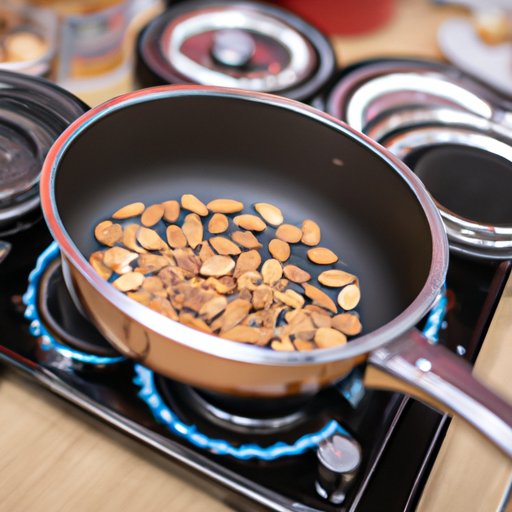Introduction
Toasting almonds is a simple but effective way to add delicious flavor and crunchy texture to a variety of snacks and recipes. When almonds are toasted, their natural oils are released, intensifying their nutty taste. Toasted almonds can be used as a topping for salads and yogurt bowls, added to baked goods, or eaten as a snack on their own. In this article, we will provide a comprehensive guide to toasting almonds, including step-by-step instructions, tips for achieving the perfect toast, and creative ideas for incorporating toasted almonds into your meals.
The Perfect Guide to Toasting Almonds: Simple Steps for a Yummy Snack
One of the most common methods for toasting almonds is on the stovetop. Here’s how:
- Place raw almonds in a dry skillet over medium heat.
- Stir occasionally until the almonds turn golden brown and become fragrant.
- Remove from heat and transfer the almonds to a plate or cutting board to cool.
When toasting almonds on the stovetop, it’s important to use a dry skillet. Any moisture in the skillet could cause the almonds to steam rather than toast, so avoid using any oil or butter.
For an extra boost of flavor, try adding spices such as cinnamon or nutmeg to the skillet before adding the almonds. You can also add a pinch of salt for a savory twist.
Crunchy and Nutty: How to Toast Almonds Like a Pro
Toasting almonds in the oven is another popular method, especially when toasting larger batches. Here’s how:
- Preheat your oven to 350°F (175°C).
- Spread raw almonds in a single layer on a baking sheet.
- Bake for 10-12 minutes, stirring occasionally, until the almonds are slightly golden.
- Remove from the oven and transfer the almonds to a plate or cutting board to cool.
When toasting almonds in the oven, make sure to watch them closely to avoid burning. Almonds can go from perfectly toasted to burnt in a matter of seconds, so it’s important to stir them frequently and keep an eye on their color.
While oven toasting takes a bit longer, it can be a great option if you need to toast a larger quantity of almonds. It can also produce a more even toast than stovetop toasting.
When comparing oven toasting vs. stovetop toasting, keep in mind that stovetop toasting is quicker and more hands-on, while oven toasting can produce a more even toast with less effort. Both methods are effective, so choose the one that works best for your needs.
Toasting Almonds: A Comprehensive Tutorial for Beginners
If you’ve never toasted almonds before, don’t worry – it’s easy! Here’s a step-by-step tutorial:
- Decide whether to toast on the stovetop or in the oven (see above steps for instructions).
- Place raw almonds in a skillet or on a baking sheet, depending on your chosen method.
- Toast until the almonds are slightly golden and fragrant. Stir or shake the skillet/pan frequently to ensure even toasting.
- Remove the almonds from heat and transfer to a plate or cutting board to cool.
It’s important to note that toasting almonds is an essential step in many recipes, as it enhances their nutty flavor and crunchy texture. Always check the recipe instructions to see if toasting is recommended.
Common pitfalls when toasting almonds include burning them or unevenly toasting them. To avoid burning, keep a close eye on the almonds and remove them from heat as soon as they start to turn golden. For even toasting, stir or shake the skillet/pan frequently and spread the almonds in a single layer on the baking sheet.
Upgrade Your Salad Toppings with Toasted Almonds: Tips and Tricks
Toasted almonds make a fantastic addition to salads, providing a satisfying crunch and nutty flavor. Here are some tips for using toasted almonds in your salad toppings:
- Add the almonds to a salad with mixed greens, fruit, and goat cheese for a flavorful combination.
- Toss the almonds in a mixture of honey, cinnamon, and salt for a sweet and spicy twist.
- Chop the almonds into small pieces for easy bite-sized toppings.
When chopping almonds for salads, try to keep the pieces relatively uniform in size. This will ensure the perfect balance of crunch and texture in each bite.
Toasting Almonds: From Stovetop to Oven, All the Techniques You Need to Know
By now, you should have a solid understanding of the basic techniques for toasting almonds. Here’s a comprehensive overview of the various methods:
- Stovetop toasting: This method is quick and hands-on, making it perfect for toasting small batches of almonds. Use a dry skillet over medium heat and stir frequently.
- Oven toasting: This method is great for larger batches of almonds and can produce an even toast. Preheat your oven to 350°F (175°C) and spread the almonds in a single layer on a baking sheet. Bake for 10-12 minutes, stirring occasionally.
When deciding which method to use, consider factors such as the quantity of almonds you need to toast and how hands-on you want to be during the toasting process. For a professional level of toast, experiment with toasting times and temperatures to find your ideal combination.
Conclusion
Toasting almonds is a quick, easy, and delicious way to add crunch and flavor to a variety of recipes. Whether you choose to toast them on the stovetop or in the oven, remember to watch them closely to avoid burning and to stir them frequently for even toasting. With a little practice, you’ll be a pro at toasting almonds in no time!
We hope this guide has been helpful in providing you with the information and confidence you need to start toasting almonds on your own. Whether you’re a beginner or a seasoned pro, adding toasted almonds to your meals is a simple way to take your dishes to the next level.
